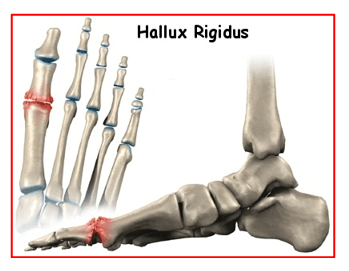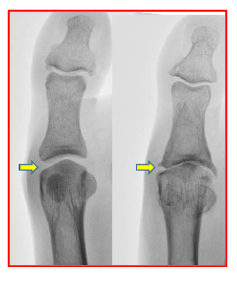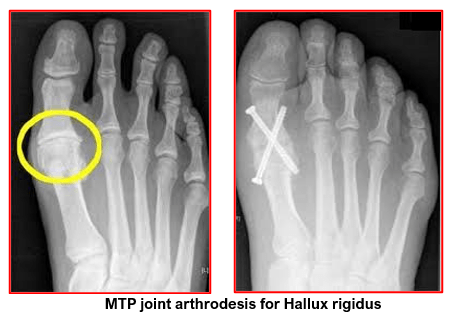Hallux Rigidus
& Its management
Hallux rigidus refers to stiffness (rigidus) of the joint at the base of the big toe (hallux). This joint is called the first metatarsophalangeal (MTP) joint.
Hallux rigidus is caused by arthritis or wear and tear of the smooth cartilage that lines the MTP joint. It may be caused by a previous injury or it may be part of a general medical condition, e.g. gout. Often the cause is unknown; it just develops, particularly as people get older.
Patients with Hallux rigidus present with pain, swelling and stiffness in the big toe MTP joint.
They have difficulty in walking far and may limp whilst walking
They also have difficulties with their work and recreational activities
Bony spurs or osteophytes develop around the big toe MTP joint and can cause pain by rubbing against tight fitting shoes.
In an attempt to off-load the painful big toe, some people tend to walk on the outer border of the foot, causing transfer pain to the lesser toes.
The diagnosis of hallux rigidus is diagnosed on the basis of patient’s medical history, clinical examination and x-rays of the foot.
Patient may give history of injury to the joint or previous fractures involving the MTP joint region. Their big toe is deformed, swollen and painful. Movements at the MTP joint are painfully limited. Patients are unable to stand on their tiptoes due to pain and joint stiffness.
X-rays of the big toe show the extent of wear and tear at the joint and presence of large osteophytes encircling the metatarsal head and also the distal phalanx.
Hallux rigidus can be managed conservatively or with surgery
Conservative measures are useful for mild hallux rigidus. The main aims are to relieve pain and decrease loading and movement through the big toe MTP joint.
These include:
- Painkiller medication for few days as needed.
- Lifestyle and activity modifications – weight loss, the use of a walking aids and the avoidance of high impact activities is advised. High heel shoes and shoes with a narrow toe box are avoided. Wearing appropriate shoe wear and orthotics (stiff insoles or shoes with a rocker bottom) is helpful.
- Corticosteroid injection may offer relief of inflammation but as with most treatments, the degree and extent of relief varies from patient to patient
Surgery is advised when the previous conservative measures fail.
There are 2 main surgical options to relieve pain and improve quality of life. The first option includes motion preserving procedures such as joint debridement +/- osteotomy, and the alternative is an arthrodesis or fusion of the MTP joint. The best option for a patient depends on many factors including the severity of arthritis, the age and functional demands of the patient, and the presence of arthritis in adjacent joints. The final choice is a joint decision between surgeon and patient.
BIG Toe MTP Joint debridement (Cheilectomy) +/- Osteotomy:
For mild hallux rigidus (affecting only the upper part of the join) – only the upper portion gets trimmed and the joint washed out. This is often combined with a realignment procedure (Moberg osteotomy) of the bone at the base of the great toe (proximal phalanx).
For more advanced cases, the joint debridement may be combined with resection of part of the proximal phalanx and the insertion of some of the surrounding soft tissue into the resulting cavity (Hamilton-Thompson Interposition Arthroplasty). This combination can provide long lasting pain relief with improved movement of the great toe in the appropriate patient.
In around 20% of patients, the arthritis is progressive, and their symptoms may come back. Such patients may need further procedure such as MTP joint fusion.
MTP Joint Arthrodesis (Fusion):
This is the ‘gold standard’ procedure for moderate to severe arthritis. The remaining cartilage in the joint is removed, the bones on either side of the joint are held together and stabilised with screws or wires or a combination of a plate and screws. The bones go on to fuse by 6 to 8 weeks.
90-95% of patients will experience good pain relief with this. But the loss of motion at the MTP joint due to fusion limits the ability to wear high heel shoes and makes running difficult. There is a small risk of developing arthritis in the next joint along the big toe, but this is rarely troublesome.
The possible risks and complications associated with surgeries for hallux rigidus are less than 5 – 10 %.
These can be:
Swelling, infection, wound healing problems, scar tenderness, damage to nerves or blood vessels of the toe, delayed union or failure of bony fusion, failure to get complete pain relief after surgery, stiffness in other joint of the big toe & need for further surgery.
Book An Appointment
Private Clinics : Locations & Directions
London Joints Clinic (Pune)
Address
Office S 5, 2nd Floor, North Block, Sacred World Mall,
Opp Sacred Heart Township, Near Jagtap Chowk,
Wanawadi, Pune 411040
Monday, Wednesday & Friday 7 PM to 9 PM
Sunday 11 AM to 1 PM
Appointments
London Joints Clinic ( PCMC )
Address
C/O Dr Nitin’s Physio Clinic,
Opp. Brahma Hotel,
Near Akurdi Post Office,
Vivek Nagar,
Akurdi,
Pune 411035
Saturdays only 4.30 PM to 7.30 PM
Appointments
Hospitals OPDs : Locations & Directions
Manipal Hospital

Address
Manipal Hospital, Opp D Mart, Baner-Mhalunge Road, Baner, Pune 411 045
Monday to Saturday 11 AM to 4 PM
Appointments
Contact us
Dr Anand Jadhav has a centralised appointment system for all locations across various hospitals and clinics in Pune & PCMC areas
Appointment Bookings & Requests can be made by any method :

